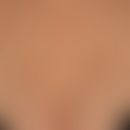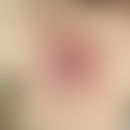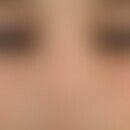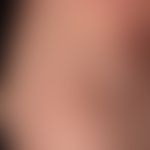Synonym(s)
HistoryThis section has been translated automatically.
DefinitionThis section has been translated automatically.
Congenital, usually bizarre and irregular (broken up outline), limited, bright, symptom-free spot, which is caused by permanent constriction of the dermal vessels (hypersensitivity to catecholamines) and is usually discovered later in life by chance.
You might also be interested in
EtiopathogenesisThis section has been translated automatically.
- Unknown, a disordered function of motor end plates of smooth vascular muscles caused by the disposition or an increased endogenous sensitivity of skin vessels to catecholamines is discussed.
- There is a high association between nevus anaemicus and neurofibromatosis type I. In > 50% of the patients with neurofibromatosis type I a N. anaemicus is found in addition to the typical café-au-lait spots gfls. together with juvenile xanthogranulomas.
- There are also known individual cases that describe a coincidence with tuberous sclerosis.
LocalizationThis section has been translated automatically.
Chest area, extremities
ClinicThis section has been translated automatically.
Coin- to palm size also larger, at the edges almost jagged, white, single or multiple count stain.
This bizarre stain is visible with varying degrees of clarity depending on the state of circulation in the surrounding area. It is particularly noticeable as a "negative contrast" when the surroundings are reddened. After intensive rubbing of the stain, in contrast to the "healthy" surroundings, no reddening of the affected skin is visible.
The boundaries to the environment disappear when printed with a glass spatula.
HistologyThis section has been translated automatically.
No vascular changes. Therefore the findings are normal.
Differential diagnosisThis section has been translated automatically.
Incontinentia pigmenti achromians: Pigmentary changes follow the Blaschko lines
Vitiligo: Acquired, migrating, borders to healthy skin not dissected, areas turn red on the rubbing test (hyperemia)
Naevus depigmentosus: congenital, pigmentary changes follow the Blaschko lines; areas turn red in the rubbing test (hyperemia)
Extragenital Lichen sclerosus: confetti-like, small-hearth distribution pattern, surface glossy.
TherapyThis section has been translated automatically.
Note(s)This section has been translated automatically.
The topical encounter of a nevus anemicus with a nevus flammeus is observed in rare cases and is called vasculartwin nevus or vascularis mixtus.
LiteratureThis section has been translated automatically.
- Ferrari F et al (2014) Juvenile xanthogranuloma and nevus anemicus in the diagnosis of neurofibromatosis type 1 JAMA Dermatol 150:42-46
- Hamm H et al (1986) Naevus vascularis mixtus. dermatologist 37: 388-392
- Hernández-Martín A et al (2015) Nevus Anemicus: A Distinctive Cutaneous Finding in Neurofibromatosis Type 1 Pediatr Dermatol doi: 10.1111/pde.12525
- Juhlin L et al (2001) Naevus anaemicus with teleangiectatic vessels. Eur J Dermatol 11: 518-520
- Marque M et al (2013) Nevus anemicus in neurofibromatosis type 1: a potential newdiagnostic criterion. J Am Acad Dermatol 69:768-775
- Plantin P, Schoenlaub P (2001) Multiple anemic macules on the arms: not a variant form of nevus anemicus. Dermatology 202: 271-272
- Sachs C et al. (2015) Nevus Anemicus and Bier spots in Tuberous Sclerosis Complex. JAMA Dermatol 18:1-2
- Sarifakioglu E et al (2006) Multiple anaemic macules of the arms: a variant of Bier's spots or naevus anemicus? J Eur Acad Dermatol Venereol 20:892-893
- Vörner H (1906) About Naevus anaemicus. Arch Dermatol Syphilis (Vienna) 82: 391-398
Incoming links (20)
Beer stains; Blood vessel nevi; Blood vessel nevi; Cutis marmorata teleangiectatica congenita; Depigmented nevus; Juvenile xanthogranuloma; Mixed nevus vascularis; Naevus; Naevus, more functional; Naevus, pharmacological; ... Show allOutgoing links (10)
Café-au-lait stain; Camouflage; Depigmented nevus; Hypomelanosis ito; Juvenile xanthogranuloma; Lichen sclerosus extragenital; Mixed nevus vascularis; Neurofibromatosis peripheral; Tuberous sclerosis; Vitiligo (overview);Disclaimer
Please ask your physician for a reliable diagnosis. This website is only meant as a reference.
















